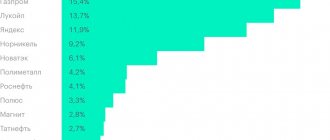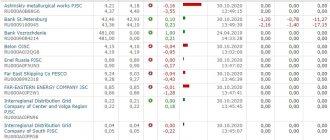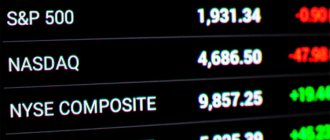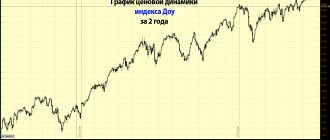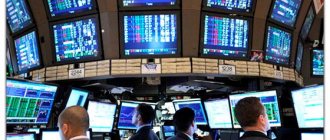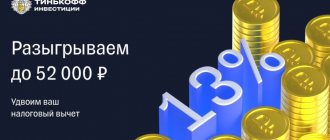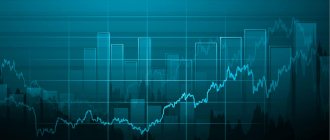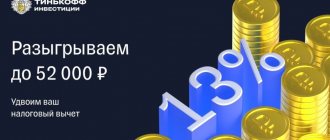Greetings! All poker players know that game chips of different denominations differ in color. The cheapest ones are usually white, while the most expensive and desirable ones are blue.
As a player with 9 years of experience, I can talk for a long time about the similarities and differences between poker and stock trading. But today I will limit myself to this fact: it was from the world of card games that one of the key concepts came to trading.
So, the topic of today’s article is the blue chips of the Russian stock market 2022. The list of companies is periodically updated. Keep this in mind when reading the article, for example, in 2022.
Blue Chip List 2019-2020
Each country has its own list. It includes first-tier companies traded on national exchanges. Let's take a closer look at the main world markets.
Russia (Mosbirzha)
The Moscow Exchange does not give an official definition of the concept of “blue chips”. However, the site maintains an index of blue chips, which includes shares of the 15 largest companies. The list is updated once a quarter depending on the liquidity of securities.
At the moment, the Moscow Exchange blue chip index includes shares of the following companies:
- Alrosa (ALRS).
- Severstal (CHMF).
- X5 Retail Group (FIVE).
- Gazprom (GAZP).
- Norilsk Nickel (GMKN).
- Lukoil (LKOH).
- Magnet (MGNT).
- MTS (MTSS).
- Novatek (NVTK).
- Rosneft (ROSN).
- Sberbank (SBER).
- Surgutneftegaz (SNGS).
- Tatneft (TATN).
- VTB Bank (VTBR).
- Yandex (YNDX).
Three companies have the largest weight in the index: Gazprom (15.37%), Lukoil (18.86%), Sberbank (17.62%). The smallest is VTB (1.55%), Severstal (1.91%).
USA
The US blue chip list includes 30 companies from the Dow Jones Industrial Average. Among them are representatives:
- banking sector (JPMorgan, Goldman Sachs);
- high-tech production (Boeing, Apple);
- retail (Walmart);
- other sectors of the economy.
Of the 30 participants, only 3 have had negative exchange rate dynamics over the past three years: Walgreens Boots Alliance Inc., Exxon Mobil Corp. and IBM.
American companies from the niftyfifty list of the 1970s
The niftyfifty (nice fifty) list included the most liquid and profitable stocks traded on the New York Stock Exchange. This unofficial rating featured 50 world-famous corporations: Coca-Cola Company, PepsiCo, Procter&Gamble, IBM, Johnson&Johnson, etc. Most of them are still blue chips in the American market today.
Europe
The 50 largest companies in the Eurozone are included in the EuroStoxx 50 index. These shares are generally considered blue chips in Europe. These include companies such as Siemens, Nokia, BMW, Airbus, Adidas. The capitalization of each of them starts from 2 trillion. rub.
Japan
The blue chips of the Japanese stock market are part of the TOPIXCore 30 index. Many of the corporations represented in it are familiar even to people far from stock exchanges. For example, the blue chips of Japan include Sony, Hitachi, Honda Motor, Canon, Nissan Motor, etc. The products of the giants can also be purchased in the Russian Federation.
China
The 50 most liquid companies of the Shanghai Stock Exchange form the SSE 50 index. It includes Bankof Beijing, SAIC Motor, Yili Group, Daqin Railway, etc. And although they are not well-known, the market capitalization of companies from this rating ranges from 36.828 billion rubles. (China Hi-Tech Group) to 11.667 trillion. R. (Kweichow Moutai).
What are “blue chips” in simple words and why are they called that?
“Blue chips” in the stock market are usually called liquid shares of the most stable companies that show strong profit growth rates. The issuers also bear the same name. Many traders compare the stock market to the gaming business, so it is no coincidence that some terms come from there. For example, blue chips in a casino have the highest value and denomination. Those. Such shares on the stock exchange are a kind of “cream”. The term is used in professional investor jargon and means that owning such assets in the long term can bring much more stable profit than an entire portfolio of a large number of low-liquid securities. Typically, the companies that produce them are leaders in the industry they represent.
The term "blue chip" was first used to describe high-value stocks in 1923, when Oliver Gingold, a Dow Jones employee, observed some stocks trading for $200 or more per share.
Distinctive features of top securities:
- High level of liquidity. This means that these securities can always be sold quickly at low costs.
- Fame. The companies that issue them are always well-known, and even people far from the world of investment know about them.
- High capitalization. These are the most capitalized companies.
- Low level of volatility. Share prices fluctuate slightly. On the one hand, they cannot soar to sky-high levels, but, on the other hand, they are also not able to “drop” significantly.
- Experience in the stock market. The most reliable shares are issued by old-time companies. They have already accumulated considerable experience, and therefore a wealth of statistical information has accumulated on them. More information means more trust.
- During its existence, the company has steadily survived economic crises without significant losses.
Blue chip market: what stocks are included
There are several criteria that allow a stock to be classified as a blue chip.
High liquidity
Tier 1 stocks are the largest companies that are trusted by investors. Due to their stable financial condition, these securities are in great demand on the stock exchange. Therefore, the sales process will not take much time.
Narrow spread
Spread is the difference between the purchase price and the sale price. But if it will be significant on securities of the second and third echelons, then when trading blue chips the spread will be minimal. As a rule, it is no more than 0.1% of the share price. This is achieved thanks to the huge trading volume and the presence of market makers on the exchange.
Low volatility
Stable financial performance of companies and the activities of market makers make it possible to avoid sharp jumps in stock prices. In terms of their reliability, such securities are practically no different from bonds of large issuers and are an attractive instrument for long-term investment.
Trading volume
Blue chips often turn out to be leaders in various ratings and constantly appear in analytical reviews. Such popularity makes these securities even more attractive to potential investors. As a result, tens of thousands of transactions are made daily on exchanges with each of them.
Capitalization
There is no clear mathematical relationship here, but capitalization is one of the indicators of a company’s reliability. It is not surprising that the most liquid shares are issued by the largest companies.
However, for each country the concept of “high capitalization” may differ markedly. Thus, the market capitalization of Sberbank at the end of 2018 was about 3.9 trillion. rub. It would seem that this is a huge amount. But if you look at the American markets, Apple is worth about $1 trillion.
Requirements for securities to be included in the prestigious list
The Moscow Exchange itself determines the criteria by which the Index Company selects 15 top shares. Until this moment, the securities must be included in 30 shares in terms of trading volume within six months. Then they rank by capitalization with free-float.
By the way, this indicator shows how many shares of a particular company are traded on the stock exchange and are available to everyone.
The higher this figure, the more accessible it is for you and me as investors.
- Gazprom's free-float is 50%
- Sberbank's free-float is 48%
Let's figure out how to choose the top 15 stocks from a large list?
There are certain parameters that should be higher than others.
Company capitalization
The indicator reflects the value of the company at the moment. It is calculated very simply: the issue volume is multiplied by the share price. But the value is very flexible, changing following the stock quotes.
For example, as of January 16, 2021, Alrosa’s capitalization is RUB 765,956,425,520. (104 * 7 364 965 630).
High liquidity
Everyone who is at least a little familiar with trading on the market knows about the “liquidity” parameter. And its meaning is also easy to understand; it shows how quickly we can, whenever we want, sell or buy assets on the stock exchange.
Even if you don’t understand anything, it’s enough to look at the book of quotes in the Quik terminal and see how quickly the numbers change there. For a liquid instrument they change almost every second. And if the stock is not liquid, then the numbers remain motionless for a long time and rarely change. But this is such a primitive method of determining liquidity.
In any case, stocks with low liquidity will definitely not make it into the top 15.
Low volatility
Volatility refers to price variability. This is even more like the stress resistance of prices to various market fluctuations, news, disasters, etc.
Investors, especially large ones, try to take stocks with low volatility into their portfolio. After all, they are considered more reliable than others.
Low spread
This indicator is very simply determined through the order book by the difference between the buy and sell prices. For companies with normal liquidity, the spread does not exceed 1% between the prices of opposite transactions. This is very easy to calculate in the same order book in the Quik trading terminal.
How to buy blue chips
Blue Chip Index
One way to invest is to purchase shares of index funds. The blue chip index on the Moscow Exchange shows the dynamics of the share prices of 15 largest Russian companies. Fluctuations in values are relatively small. Despite difficult conditions, over the past 10 years the index has grown by more than 50%.
Chip quotes on MICEX
Despite the high capitalization of companies, their stock prices are quite affordable for any investor.
So, for only 235 rubles. you can become a co-owner of Sberbank, and for 159 rubles. - Gazprom.
The most expensive securities today are Norilsk Nickel. To become the owner of one such share, an investor will have to shell out more than 14 thousand rubles.
In addition to stable price growth, blue chips have another advantage over second- and third-tier stocks. Most companies consistently pay dividends to their owners.
Share quotes can be viewed on the official website of the Moscow Exchange.
Advantages and disadvantages
What is good about such investments is that they bring the trader a small, but stable income in the long term. But in order to understand in detail whether it is really worth investing in them, let’s consider their main advantages and disadvantages.
Pros of trading securities:
- Obtaining a stable income in the long term.
- Minimal risks of company bankruptcy or a significant “subsidence” of the stock quote (rate).
Minuses:
- The need to invest funds for a long period of time.
- Low profitability due to overvaluation of shares on the market.
- Low attractiveness of Russian companies compared to similar securities issued by foreign companies.
Dividend Stability Index
The DSI index shows how regularly a company pays dividends and increases their size. The indicator is historical, that is, it does not include the risks of future changes in dividend policy.
The closer the DSI is to one, the better: this indicates that dividends have been regularly paid and increased for seven years in a row. This means there is a high probability that this trend will continue. If the DSI value is from 0.3 to 0.6, then the company pays dividends irregularly.
For example, Novatek and Lukoil are among the most stable payers: the DSI values for them are 1 and 0.93, respectively.
This index can be used by investors as one of the criteria when selecting securities for a dividend portfolio.
